
Geum, commonly called avens, is a genus of about 50 species of rhizomatous perennial herbaceous plants in the rose family and its subfamily Rosoideae, widespread across Europe, Asia, North and South America, Africa, and New Zealand. They are closely related to Potentilla and Fragaria. From a basal rosette of leaves, they produce flowers on wiry stalks, in shades of white, red, yellow, and orange, in midsummer. Geum species are evergreen except where winter temperatures drop below 0 °F (−18 °C). The cultivars 'Lady Stratheden', and 'Mrs J. Bradshaw' have gained the Royal Horticultural Society's Award of Garden Merit.

Silphium is a genus of North American plants in the tribe Heliantheae within the family Asteraceae.

Silphium laciniatum is a species of flowering plant in the family Asteraceae known commonly as compassplant or compass plant. It is native to North America, where it occurs in Ontario in Canada and the eastern and central United States as far west as New Mexico. Other common names include prairie compass plant, pilotweed, polarplant, gum weed, cut-leaf silphium, and turpentine plant. It is a rosinweed of genus Silphium.
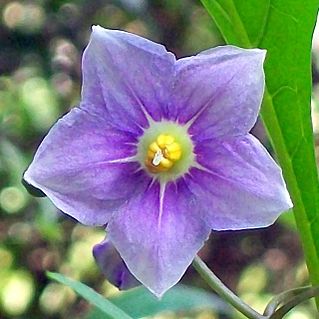
Solanum aviculare, commonly called poroporo, bumurra (Dharug), kangaroo apple, pam plum (Australia), or New Zealand nightshade, is a soft-wooded shrub native to New Zealand and the east coast of Australia. Other names used for Solanum aviculare in the Māori language include pōporo, hōreto, and peoi.
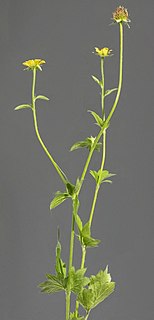
Geum urbanum, also known as wood avens, herb Bennet, colewort and St. Benedict's herb, is a perennial plant in the rose family (Rosaceae), which grows in shady places in the temperate regions of Eurasia. It has been introduced in North America, where it forms natural hybrids with Geum canadense.

Teucrium is a cosmopolitan genus of flowering plants in the family Lamiaceae, commonly known as germanders. Plants in this genus are perennial herbs or shrubs, with branches that are more or less square in cross-section, leaves arranged in opposite pairs, and flowers arranged in thyrses, the corolla with mostly white to cream-coloured, lobed petals.
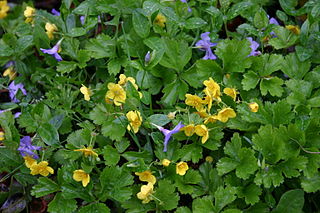
Waldsteinia fragarioides (syn. Dalibarda fragarioides Michx. and Geum fragarioides, also called Appalachian barren strawberry, or just barren strawberry, is a low, spreading plant with showy yellow flowers that appear in early spring. This plant is often used as an underplanting in perennial gardens.
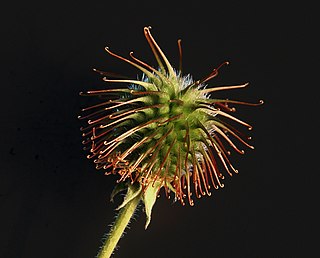
A bur is a seed or dry fruit or infructescence that has hooks or teeth. The main function of the bur is to spread the seeds of the bur plant, often through epizoochory. The hooks of the bur are used to catch on to for example fur or fabric, so that the bur, which contain seeds, then can be transported along with the thing it attached itself to. Another use for the spines and hooks are physical protection against herbivores. Their ability to stick to animals and fabrics has shaped their reputation as bothersome.

Geum quellyon, commonly called scarlet avens, Chilean avens, Double Bloody Mary, or Grecian rose, is a perennial herb in the family Rosaceae. It is native to the central and southern regions of Chile. G. quellyon has been introduced to other countries including Belgium, Bolivia, and the United Kingdom, where it was first planted in 1826.
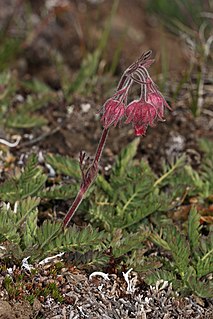
Geum triflorum, prairie smoke, three-flowered avens, or old man's whiskers, is a spring-blooming perennial herbaceous plant of North America from northern Canada to California and east to New York. The flowers bloom from mid-spring to early summer.
Kokia kauaiensis, the Kauai treecotton or Kauaʻi Kokiʻo, is a species of flowering plant in the mallow family, Malvaceae, that is endemic to Kauaʻi, Hawaii.

Eupatorium hyssopifolium, also known as hyssopleaf thoroughwort, is a fall-blooming herbaceous plant native to North America. Like other members of the genus Eupatorium it has inflorescences containing a large number of very small flower heads, each with 5 white disc florets but no ray florets. At 0.5 to one meter tall, it is towards the shorter end of the range of heights found in Eupatorium species.
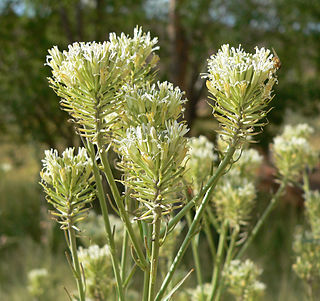
Thelypodium is a genus of flowering plants in the mustard family. There are 16 to 20 species, all native to western North America. Thelypody is a common name for plants in this genus.

Thelypodium laciniatum is a species of flowering plant in the mustard family known by the common name cutleaf thelypody. It is native to western North America, particularly the Great Basin and surrounding plateau and foothill habitat, where it grows on dry rocky cliffs and hillsides in sagebrush and scrub, usually below 2,400 metres (8,000 ft) elevation.
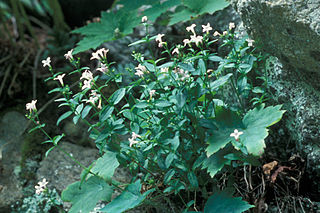
Houstonia purpurea is a species of flowering plant in the coffee family known by the common names Venus's pride, woodland bluet, and purple bluet. It is native to the eastern United States from eastern Texas and Oklahoma east to Florida and Pennsylvania, with scattered populations in Nebraska, Iowa, Michigan, New York State and New England.
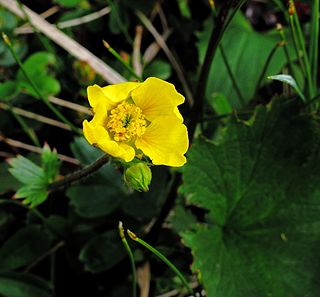
Geum peckii is a species of herbaceous, perennial flowering plant in the rose family known by the common name mountain avens. It is native to eastern North America, where it is known from only two locations, the White Mountains of New Hampshire and three sites in Nova Scotia.
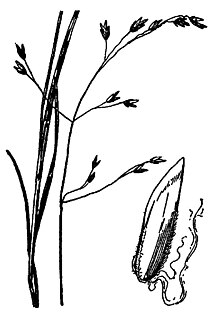
Poa paludigena is a species of grass known by the common names bog bluegrass, marsh bluegrass, slender marsh bluegrass, and Patterson's bluegrass. It is native to the northeastern United States.
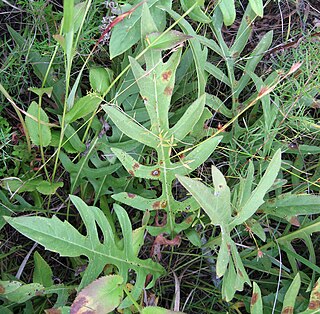
Silphium pinnatifidum, the tansy rosinweed or cutleaf prairie dock, is a species of flowering plant in the family Asteraceae. It is native to the Southeastern United States where it is found in Alabama, Georgia, Kentucky, and Tennessee. Its habitat is prairies, barrens, and cedar glades.
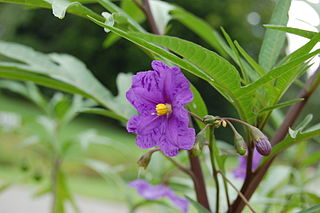
Solanum laciniatum is a soft-wooded shrub native to the east coast of Australia, notably Victoria and Tasmania. It also occurs in Western Australia and New Zealand, where some authorities consider it to be introduced. It is similar to Solanum aviculare, with which it shares the common name kangaroo apple. The common name refers to the likeness of the leaf shape to a kangaroo paw print. This plant is currently being cultivated to produce corticosteroid drugs.


















